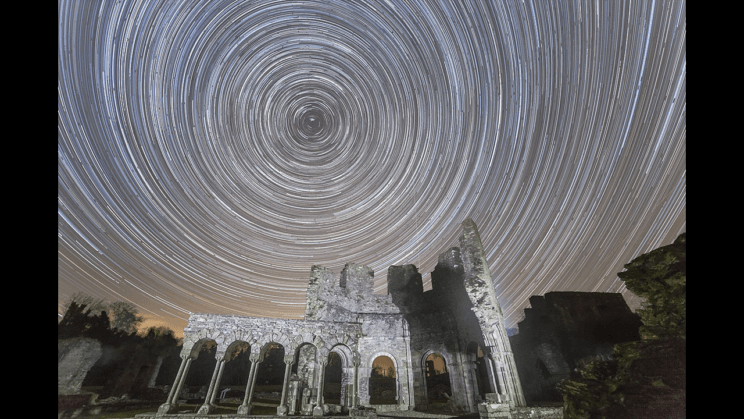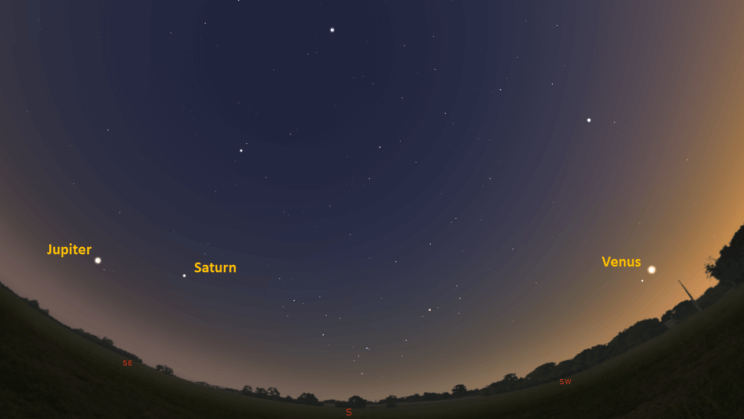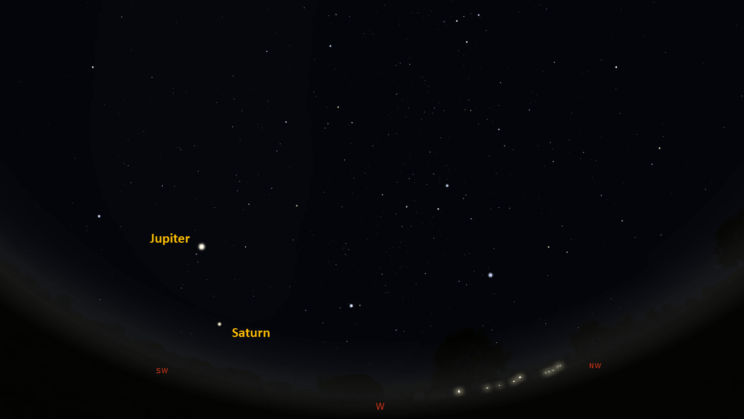This is the Saint Louis Science Center’s NIGHT SKY UPDATE for the week of Friday, September 3, 2021.
Information updated weekly or as needed.
Times given as local St. Louis time, which is Central Daylight Time (CDT). For definitions of terminology used in the night sky update, click the highlighted text. If relying on times posted in Universal Time (UT), St. Louis is -5 hours when CDT.
Public Telescope Viewings
With the changing recommendations from the CDC regarding COVID-19, conversations regarding the return of star parties at the Saint Louis Science Center have begun. We are close to bringing back our public telescope viewings, but a few details still need to be worked out. We will post future updates as we learn more about when we can bring back telescope viewings.
Observing Highlight of the Week

This 3-hour long star trail image shows the circumpolar sky from Ireland.
Image credit: Astro Anthony
This week we will turn our attention to the circumpolar sky. In the northern hemisphere, looking north, you find a section of sky that never dips below the horizon. The amount of the sky that is considered circumpolar is dependent on your latitude. The farther north you live, the larger the circumpolar sky becomes. The circumpolar sky is dependent on your latitude because the term circumpolar means “situated around or inhabiting Earth’s poles”. If we apply this to astronomy, it references the objects seen near the north or south celestial poles. The key to identifying the northern circumpolar sky is to find the North Star.
Most are aware that the North Star (currently Polaris) is the nearest bright star to the point in the sky that Earth’s north pole points towards. If you watch Polaris from sunset to sunrise, it will always appear to be in the same spot. There is a slight apparent motion to Polaris over an evening but not one you will notice if just checking on the star’s position from hour to hour. Measuring the altitude of the North Star from your location is a measure of your latitude. Here in St. Louis, Missouri, the North Star is roughly 38.6° above the northern horizon. Visually, this means that anything in the sky that is 38° or less from the North Star will always be visible once it is dark. What you see is also dependent on your horizon. If you have lots of trees or buildings to the north, they will obscure what is low to the horizon.
A good example is the famous asterism called the Big Dipper. Found in the constellation Ursa Major, the Big Dipper is well-known to us as the pattern that helps us find the current North Star. Following a line through the two stars at the end of the Big Dipper’s bowl is what points us to North Star. Being this close to Polaris means the Big Dipper will appear to shift around the North Star never dipping below the horizon.
In addition to the Big Dipper, you will also find the Little Dipper (in Ursa Minor), Draco the Dragon, Cepheus, Cassiopeia, and Camelopardalis in our circumpolar sky. If you watch these famous patterns, you will see how all night long, they just circle around the pole star.
Other points of interest to look for in our circumpolar sky are Messier 51 and 101 also known as the Whirlpool and Pinwheel galaxies, Delta Cephei and Herschel’s “Garnet Star,” and finally Kemble’s Cascade in Camelopardalis. These are but a few of the various objects worth tracking down in our circumpolar sky if you have binoculars or a telescope.
To help you identify the circumpolar sky, you can use the interactive star chart found at heavens-above.com. Make sure that it is set up for your own location to get the most accurate information. The map you will find here will show you the constellations you would see for a given date and time. If you cycle through the hours, you will see how part of the northern sky never really sets. Another resource to use if you are having trouble finding the circumpolar sky is the free planetarium software Stellarium. This is available for all platforms and it is a great tool for planning a session of star gazing.
The Sun and Moon

The Moon as seen from the International Space Station, on July 31, 2011.
Credit: NASA
Sunrise is at 6:32 a.m. on Friday, September 3 and sunset is at 7:27 p.m. providing us with a bit less than 13 hours of daylight. Even after sunset, the light from the Sun will dimly illuminate our sky for roughly 1 hour and 30 minutes. This period is called twilight, which ends around 9:00 p.m. this week. For those with a sundial, local noon occurs around 12:59 p.m. this week.
| Day | Sunrise | Sunset |
|---|---|---|
| 2021-09-03 | 6:32 a.m. | 7:27 p.m. |
| 2021-09-04 | 6:33 a.m. | 7:26 p.m. |
| 2021-09-05 | 6:34 a.m. | 7:24 p.m. |
| 2021-09-06 | 6:35 a.m. | 7:23 p.m. |
| 2021-09-07 | 6:35 a.m. | 7:21 p.m. |
| 2021-09-08 | 6:36 a.m. | 7:19 p.m. |
| 2021-09-09 | 6:37 a.m. | 7:18 p.m. |
| 2021-09-10 | 6:38 a.m. | 7:16 p.m. |
| 2021-09-11 | 6:38 a.m. | 7:15 p.m. |
Moon
Moonrise for Friday, September 3 occurred at 2:38 a.m. and moonset occurred at 5:57 p.m. On Friday, September 3 the Moon will exhibit a waning crescent phase with about 11% of the lunar disk illuminated. New moon occurs on September 6 at 7:52 p.m.
International Space Station (ISS) Observing

Visible passes of ISS from St. Louis for the week of September 3 occur during morning hours. The best pass this week occurs on the morning of September 11. Use the table below for information about this and other visible passes this week.
Catch ISS from St. Louis starting Friday, September 3
| Date | Starts | Max. altitude | Ends | |||||||
|---|---|---|---|---|---|---|---|---|---|---|
| Time | Alt. | Az. | Time | Alt. | Az. | Time | Alt. | Az. | ||
| 07 Sep | -1.1 | 05:28:48 | 10 | NNW | 05:31:14 | 18 | NNE | 05:33:40 | 10 | ENE |
| 08 Sep | -0.8 | 04:42:01 | 10 | NNW | 04:43:56 | 14 | NNE | 04:45:50 | 10 | NE |
| 09 Sep | -2.3 | 05:30:59 | 10 | NW | 05:34:10 | 37 | NNE | 05:37:21 | 10 | ESE |
| 10 Sep | -1.6 | 04:45:14 | 17 | NNW | 04:46:58 | 25 | NNE | 04:49:51 | 10 | E |
| 11 Sep | -0.7 | 04:00:50 | 16 | NE | 04:00:50 | 16 | NE | 04:02:10 | 10 | ENE |
| 11 Sep | -3.9 | 05:33:53 | 13 | NW | 05:36:51 | 72 | SW | 05:40:12 | 10 | SE |
Magnitude (Mag): The Measure of brightness for a celestial object. The lower the value is, the brighter the object will be.
Altitude (Alt): The angle of a celestial object measured upwards from the observer’s horizon.
Azimuth (Az): The direction of a celestial object, measured clockwise from an observer’s location with north being 0°, east being 90°, south being 180° and west being 270°.
For information about ISS flyovers and other visible satellites, visit www.heavens-above.com
Detailed information regarding all unmanned exploration of our universe, missions past, present, and planned, can be found at Jet Propulsion Laboratories:
The Visible Planets

Looking South, at 8:00 p.m. September 3, 2021
Credit: Stellarium, EG

Looking West, at 2:30 am, September 3, 2021
Credit: Stellarium, EG
This week, three naked eye planets are visible. Venus can be found in the west after sunset. Jupiter and Saturn can be found in the southeast after sunset.
Mercury
Mercury has started another evening apparition but this one will be tough. Even though Mercury is bright enough to see naked eye, it never strays far from where the Sun is found. Additionally, the angle of the ecliptic we see at sunset right now is decreasing meaning even when Mercury reaches maximum elongation, on September 13, 2021, it will not be seen very high above the horizon.
Venus
Venus is well into another evening apparition. By 7:47 p.m., Venus will be about 13° above the western horizon. Venus will set at 8:59 p.m. As 2021 continues, Venus will continue to elongate from the Sun until October 29 when it reaches maximum eastern elongation. After this date Venus will start to head back towards the Sun as it approaches inferior conjunction on January 8, 2022.
Jupiter
Jupiter has passed opposition and as such will be visible about 30 minutes after sunset. Look for Jupiter in the southeast as it starts to darken outside. Jupiter sets at 5:14a.m. tomorrow morning and will set about 30 minutes earlier each week. Jupiter reaches superior conjunction on March 5, 2022. This means we can count on seeing Jupiter in the south for the rest of this year and well into 2022.
Saturn
Saturn is past opposition which means it will be visible about 30 minutes after sunset. Right now, it can be found in the southeast after sunset, but as we continue through the year, Saturn will set about 30 minutes earlier each night. Saturn sets at 3:47 a.m. Saturn will reach superior conjunction on February 4, 2022.
James S. McDonnell Planetarium
Night Sky Update: September 3-September 11, 2021






